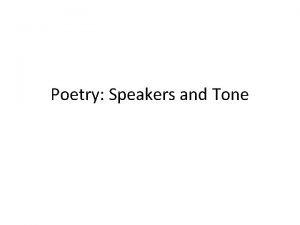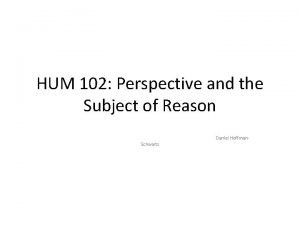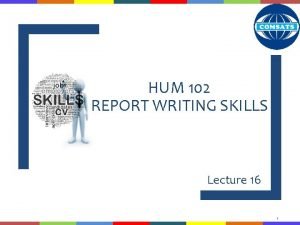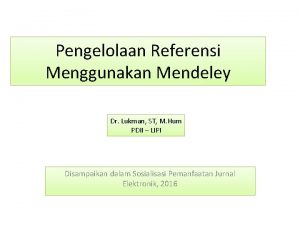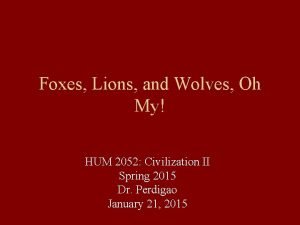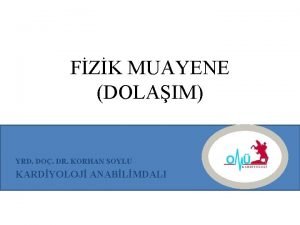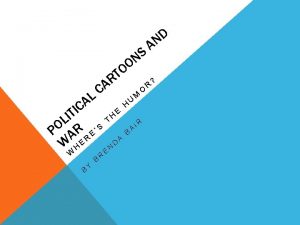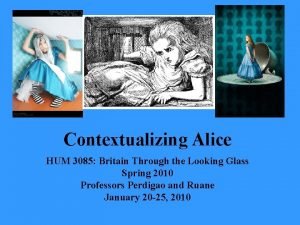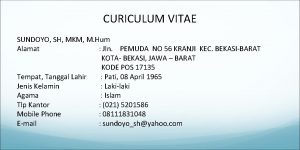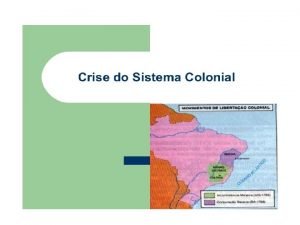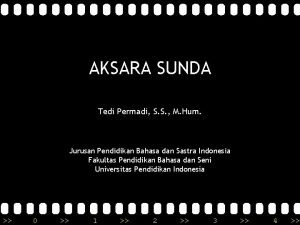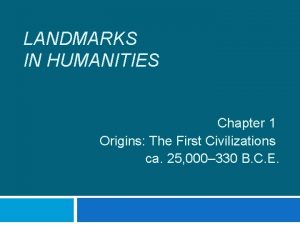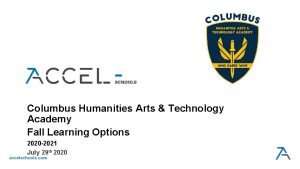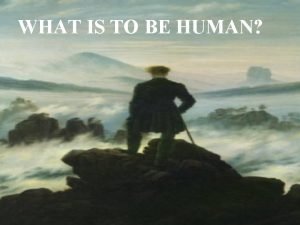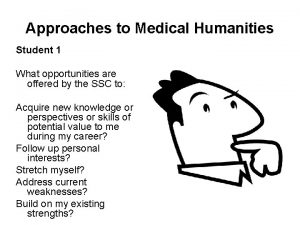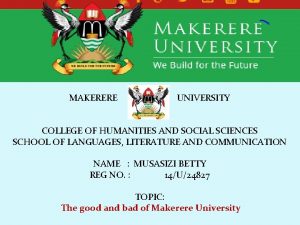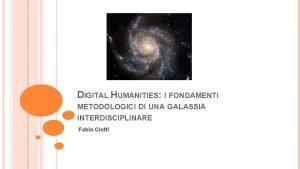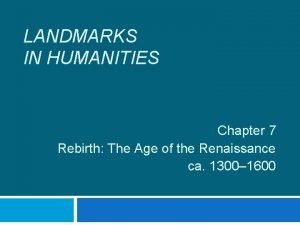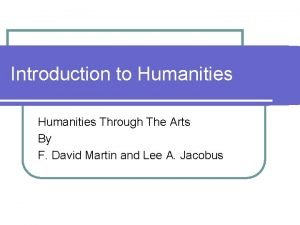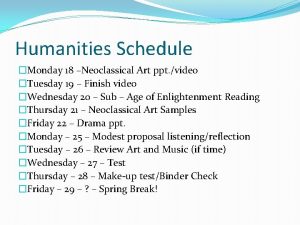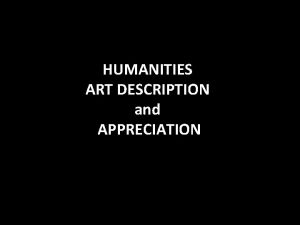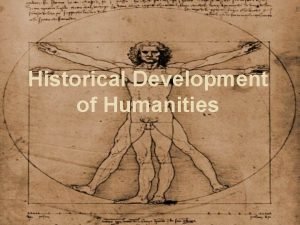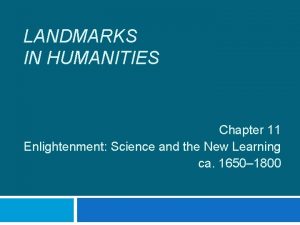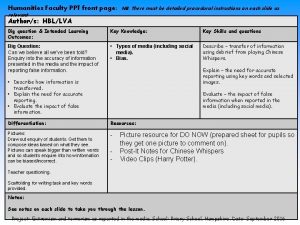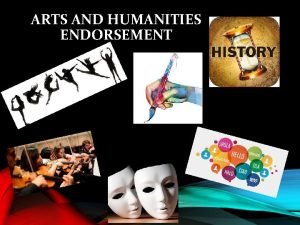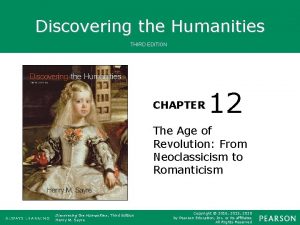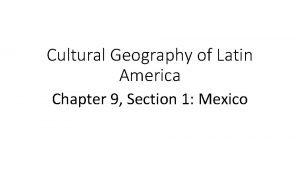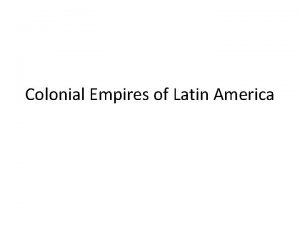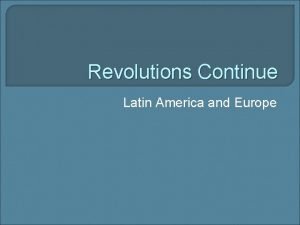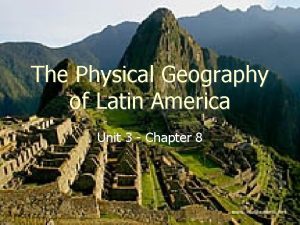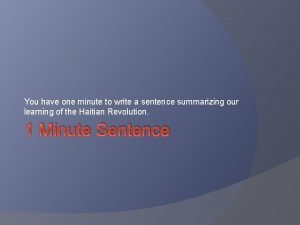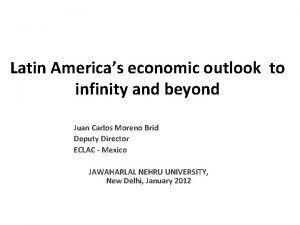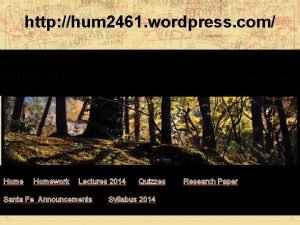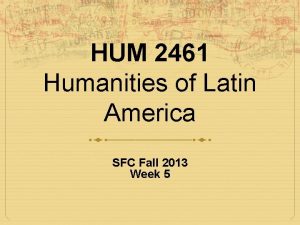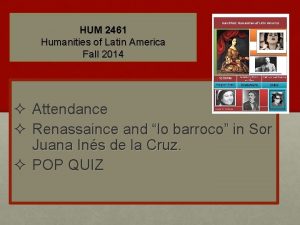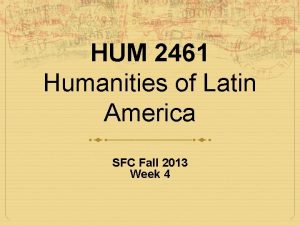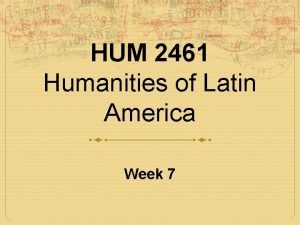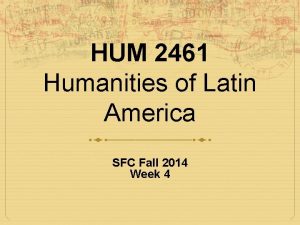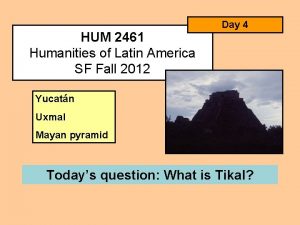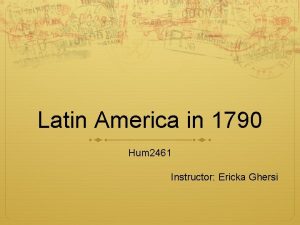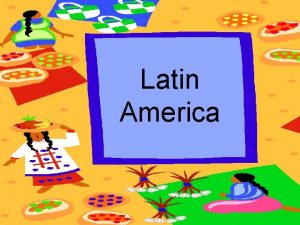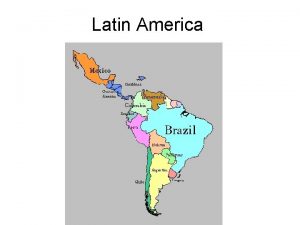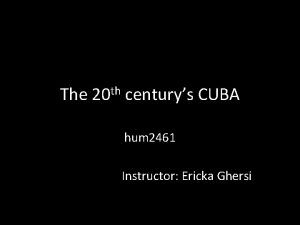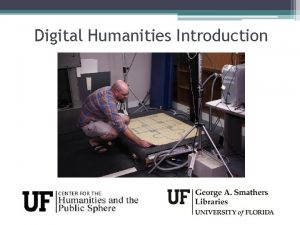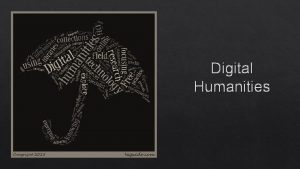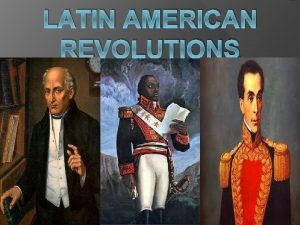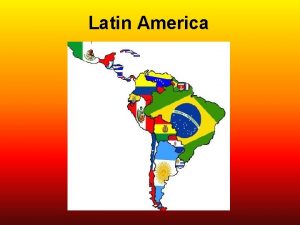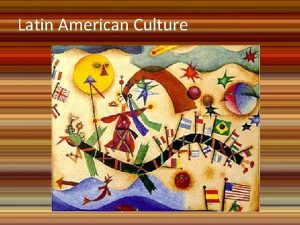HUM 2461 Humanities of Latin America Spring 2013
























































- Slides: 56

HUM 2461 Humanities of Latin America Spring 2013 ² ² Day 22 12 th of November Attendance Renassaince and “lo barroco. ” Inca Garcilaso de la Vega. Sor Juana Inés de la Cruz.

Activity #1 1. Students have to take notes from this presentation. 2. End of class student will take a quiz for EXTRA CREDIT in the MIDTERM exam.

What is Renaissance? ² Age of Enlightenment or Age of Reason. ²It’s the period of European history at the end of the Middle Ages and the rise of the modern world. ²It’s a cultural rebirth from the 14 th through the middle of the 17 th centuries. ²It’s the humanistic revival of classical forms such as art, architecture and music.

Characteristics of Renaissance 1. Growing split between secular and religious powers. 2. Knowledge began to be democratized. 3. Individuals began to assert their private right to seek and achieve personal glory and fame.

What is lo barroco? ²It’s an artistic style encouraged by the Roman Catholic Church. ²It should communicate religious themes in direct and emotional involvement. ²It was characterized by new exploration of forms: light/shadow and dramatic intensity.

What is lo barroco? ²Baroque art was meant to evoke emotion and passion instead of the calm rationality that had been prized during the Renaissance. ²As opposed to Renaissance art, which usually showed the moment before an event took place, Baroque artists chose the most dramatic point, the moment when the action was occurring.

El inca garcilaso de la vega Inca Empire Tawantinsuyo Cusco

lo barroco in peru Cuzco School of Art: 1. Used bright colors and distorted (Mannerist style), dramatic images 2. Predominance of red, yellow and earth colors. 3. Remarkable for their lavish use of gold leaf, especially with images of the Virgin Mary. 4. Warrior angels became a popular motif in Cusqueña paintings.

characteristics of lo barroco in literature ² Extreme decoration ² Subtle conceits (clever plays on words): language is “slippery ground” ² Maximum culture (knowledge, all the reading of humanities) ² Extreme respect to the authority

Inca Garcilaso de la Vega (16 th century) ²Gómez Suárez de Figueroa ²El Inca ²Cusco, 12 April 1539 – Spain, 23 April 1616 ²Chronicler and writer

The Dilemma in the inca garcilaso From two different worlds: ² He was the illegitimate son of Spanish captain and conquistador Sebastián Garcilaso de la Vega y Vargas (d. 1559). ² And Garcilaso's mother was the Inca princess Palla Chimpu Ocllo (Isabel Suárez Chimpu Ocllo), descended from Inca nobility, daughter of Túpac Huallpa and granddaughter of the powerful Inca Tupac Yupanqui.

His position in the new world (Spain) ²First bilingual writer (Quechua & Spanish) ² First educated indigenous, but he was “The Other” ² Nobility did not help much in Spain. ² Ambassador of the Inca Empire. ² Need of teaching Spaniards about Inca culture throughout writing. ² In spite of being a man, he did not have a position in the Spanish patriarchal society (just like

Why did he choose literature in stead of other artistic expression? ² Because of his dilemma heritage from two powerful worlds: ² Inca Empire ² The new country Spain. ² Because of his participation in one of the many revolts against the Crown in Cusco: ²His father (Spanish captain and conquistador Sebastián Garcilaso de la Vega y Vargas) was dishonorable discharged by the Crown.

His writings ² La Florida del Inca (Lisbón, 1605) • It’s an account of Hernando de Soto's expedition and journey of Florida. ² Comentarios reales de los Incas (Lisbón, 1609/1616) / The Royal Commentaries of the Incas (English translation, 1961) ²It’s an account of the Inca culture (it’s history, arts and architecture, and religion)

La Florida del Inca (Lisbón, 1605) ²El Inca Garcilaso gathered during various years information related to Sotos’s expedition to Florida. ²In these writings El Inca Garcilaso defends the legitimacy of imposing the Spanish sovereignty in conquered territories and submit them to Christian jurisdiction. ²But he also defends the dignity, courage and rationality of the Native Americans.

LIBRO I -- CAPITULO II Descripcio n de la Florida, y el primer descubridor della, y el segundo y el tercero El primer espan ol que descubrió la Florida fue Juan Ponce de Leo n, caballero natural del reino de Leo n, hombre noble, el cual, habiendo sido gobernador de la isla de San Juan de Puerto Rico, como entonces no entendiesen los espan oles sino en descubrir nuevas tierras, armó dos carabelas y fue en demanda de una isla que llamaban Bimini y segu n otros Buyoca, donde los indios fabulosamente deci an habi a una fuente que remozaba a los viejos, en demanda de la cual anduvo muchos di as perdido, sin la hallar. Al cabo de ellos, con tormenta, dio en la costa al septentrio n de la isla de Cuba, la

LIBRO I -- CHAPTER III THOSE WHO HAVE ATTEMPTED THE CONQUEST OF FLORIDA. JUAN PONCE DE LEON Was the first who discovered Florida. Ile was a gentleman, born in the kingdom of Leon, and had been governor of the island of Porto Rico. As the Spaniards then thought only of making new discoveries, he equipped two caravels, and endeavored by every means to discover the island of Bimini, on account of the report that there was there a fountain which restored youth to old men. But after having searched in vain for this island, a tempest cast him upon the coast which is opposite the north part of Cuba; and he named this continent Florida, and without considering whether it was an island or the

Comentarios reales de los Incas (Lisbón, 1609) ²The book is a relación, a letter of appeal to the Council of the Indies to have his father’s name cleared and Garcialso’s petition granted. ²It’s an exemplary history of the two sides of his family. ²Divided in two parts: ² 1 st part tells the story of the Inca emperors from he claims descend on his mother’s side. Published 1609. ² 2 nd part narrates the history of the conquest of Perú by the Spaniards. Published 1616.

Comentarios reales de los Incas (Lisbón, 1609) ²Employs the high Renaissance style, but the reality of the Inca situation imposed on him “compliance with the discourse of the State. ” ²It’s “barroco” because he gives details account of names and dates that in the end it is the legal rhetoric that dismantles the other and predominate the Inca’s discourse. ²It’s a text divided by his mestizo identity, and appealing for truth.

Comentarios reales de los Incas (Lisbón, 1609) ² SPANISH VERSION: ²Libro I – Capítulo XV “El orígen de los Incas reyes del Perú” (p 47) ²ENGLISH VERSION: ²Book I -- Chapter VII “The Original of the Incas, Who Were Kings of Perú” (p 11)

Libro I – Capítulo XV “El orígen de los Incas reyes del Perú” Viviendo o muriendo aquellas gentes de la manera que hemos visto, permitió Dios Nuestro Señor que de ellos mismos saliese un lucero del alba que en aquellas oscurísimas tinieblas les diese alguna noticia de la ley natural y de la urbanidad y respetos que los hombres debían tenerse unos a otros, y que los descendientes de aquél, procediendo de bien en mejor cultivasen aquellas fieras y las convirtiesen en hombres, haciéndoles capaces de razón y de cualquiera buena doctrina, para que cuando ese mismo Dios, sol de justicia, tuviese por bien de enviar la luz de sus divinos rayos a aquellos

Pop QUIZ 1. What is Renaissance? 2. What is Baroque? 3. What is “lo barroco” in Perú? 4. Who is the maximum exponent in literature? 5. What does he represent? 6. What did he write?


HUM 2461 Humanities of Latin America Spring 2013 Day 223 12 th of November ² Attendance ² Renassaince and “lo barroco” in Sor Juana Inés de la Cruz. ² POP QUIZ

Activity #1 1. Students have to take notes from this presentation. 2. End of class student will take a quiz for EXTRA CREDIT in the MIDTERM exam.

Sor juan inés de la cruz Aztec Empire Mesoamérica México

lo barroco in mexico ²A profusion of adornment in all the arts, and ²A complicated façades, abundant foliage, plaster darts, crossings, coiling, scrolls, and conical shapes mixed with traditional shapes in sculpture and architecture.

characteristics of lo barroco in literature ² Extreme decoration ² Subtle conceits (clever plays on words): language is “slippery ground” ² Maximum culture (knowledge, all the reading of humanities) ² Pessimism ² Metaphor “a sea of troubles” ² Stark opposites (light//dark) ² Veras and burlas

METAPHOR ²A figure of speech in which a word or phrase that ordinarily designates one thing is used to designate another, thus making an implicit comparison, as in "a sea of troubles" or "All the world's a stage" (Shakespeare). ²Which is your? , get a piece of paper and write down a metaphor!

Sor juana inés de la cruz (17 th century) ²Juana de Asbaje y Ramírez ²Sor Juana ²México, nov. 12 th, 1651 April 17 th, 1695 ²Writer and poet.

1651 - 1695 / San Miguel Nepantla / Mexico

Two main contributions 1. Against the role of church. Expressed in prose, mainly. 1. Against patriarchal societies. Expressed in poetry.

Most important literary work ²Sor Juana Inés de la Cruz was an exceptional XVII-century nun who set precedents for feminism long before the term or concept existed. ²Her defense (letter) "Respuesta a Sor Filotea” (Reply to Sister Philothea) is a maverick work outlining the logical sense of women’s education more than 200 years before Virginia Woolf’s “A Room of One’s Own. ” ²Her poetry, meanwhile, states in bold language the potency of the feminine in both love and religion. ²Poems such as “You Men” and “First Dream” pointed out how women were mistreated by men and society.

1) Against the role of church: “Respuesta a sor filotea” What is “Respuesta a Sor Filotea”? It is an answer to Francisco Aguiar y Seijas, Archbishop of Mexico, defending herself.

respuesta a sor filotea ²Gives a critique of Padre Antonio de Vieira’s famous sermon. ²Bishop of Puebla publishes it as “Missive Worthy of Athena. ” (1691) ²Includes a letter of his own, admonishing Sor Juana for her “Intellectualism” under the pen name Sor Philothea de la Cruz.

Fragments of “respuesta a sor filotea” 1. The publication of my work is a blessing which makes me feel unworthy. 2. I can’t thank you because I don’t know how, not because I’m ungrateful. I want to benefit more from your goodness; you can help to shape my intellect. 3. But your kindness does prompt me to answer, and I understand your warning to be against my secular writings. But how should I write of sacred things if I might misunderstand them? I don’t study to write or teach but to be less

Fragments of “respuesta a sor filotea” 4. How much harm would be avoided in our country if older women were as learned as Laeta and knew how to teach in the way Saint Paul and my Father Saint Jerome direct! 5. Instead of which, if fathers wish to educate their daughters beyond what is customary, for want of trained older women and on account of the extreme negligence which has become women's sad lot, since well-educated older women are unavailable, they are obliged to bring in men teachers to give instruction…

Fragments of “respuesta a sor filotea” 6. As a result of this, many fathers prefer leaving their daughters in a barbaric, uncultivated state to exposing them to an evident danger such a familiarity with men breeds.

Some points 1. Laeta’s knowledge Be able to learn (women can have knowledge as Laeta). 2. Saint Paul and Father Saint Jerome be able to teach (women can teach women). 3. Uneducated women Ignorance is dangerous. 4. Women become an easy prey Opens discussion over rape.

Last lines of “respuesta…” 57. And if you say I shouldn’t write poetry because I am a woman, you are saying the evil is in my being a woman – because there is no evil in poetry. Besides, I’ve only written when begged to by others. Even the piece you respond to [the prose critique] was not written by my own volition and I did not intend someone like you to ever read it. It has been criticized, but I deem it better not to defend it, because the truth will speak for itself. Praise is more harmful than criticism, anyway, as it tempts one to pride. 58. I will ask your correction of any further writing I do. 59. I hope I have not been too familiar. 60. I request God’s blessings on you.

Conclusions for “RESPUESTA…” ²Sor Juana turned around the logic used by the Church to justify her oppression and subverted it into a magnificent defense for women's intellectual rights and education. ²Though the letter’s tone is superficially humble, Sor Juana forcefully insists that women have a natural right to the mind. Her use of biblical evidence to support her call for strong, educated women is downright clever -- and has earned her recognition for her rhetorical skills.

Conclusions for “RESPUESTA…” ²“Respuesta a Sor Filotea” brought indignation from the Church and unwanted attention from the Inquisition. ² To save herself, Sor Juana was forced to stop writing and to give up her books.

Characteristics of baroque On her writing (? ) On her life (? ) On her attitude (? )

2) Against patriarchal societies. through POETRY: “YOU men” Hombres necios que acusáis a la mujer sin razón, sin ver que sois la ocasión de lo mismo que culpáis: si con ansia sin igual solicitáis su desdén, ¿por qué quereis que obren bien si las incitáis al mal? Combatís su resistencia y luego, con gravedad, decís que fue liviandad Silly, you men-so very adept at wrongly faulting womankind, not seeing you're alone to blame for faults you plant in woman's mind. After you've won by urgent plea the right to tarnish her good name, you still expect her to behave— you, that coaxed her into shame. You batter her resistance down and then, all righteousness, proclaim that feminine frivolity,

“YOU men” Pues ¿para qué os espantáis de la culpa que tenéis? So why are you men all so stunned Queredlas cual las hacéis at the thought you're all guilty o hacedlas cual las buscáis. alike? Dejad de solicitar, y después, con más razón, acusaréis la afición de la que os fuere a rogar. Bien con muchas armas fundo que lidia vuestra arrogancia, pues en promesa e instancia Either like them for what you've made them or make of them what you can like. If you'd give up pursuing them, you'd discover, without a doubt, you've a stronger case to make against those who seek you out. I well know what powerful arms you wield in pressing for evil: your arrogance is allied

Dream vision DREAM ALLEGORY ² Emerged as a poetic genre in the Middle Ages. ² Kind of narrative. ² Narrator falls asleep and dreams the events of the tale. ² The story is often a kind of allegory a tour of some marvelous realm. ² Dante Alighieri The Divine Comedy (c. 1320) ² The dream vision was much favored by medieval poets, most of them influenced by the 13 th‐century Roman de la rose by the French poets Guillaume de Lorris and Jean de Meung.

First Dream, 1692 Primero sueño ² Her most celebrated work. ² Silva (a poetic form combining verses of 7 and 11 syllables) ² Describes through the form of a dream the soul's rising toward knowledge, employing extensively Sor Juana's knowledge of the sciences. ² The poem is baroque style, yet seems to foreshadow the Enlightenment in its scientifically oriented worldview. ² Interpretations of ”Primero sueño” are diverse. It has been variously described as metaphysical, as a defense of the private viewpoint, and as a work that in outlook foreshadows modern Mexican nihilism. ² Regardless of interpretation, it is perhaps her most important piece, particularly because of her claim that it was the only work she composed on her own impulse rather than at the request of another.

Spanish poets leading topics similar to hers: death • Jorge Manrique (1440 -1479) • “Coplas por la muerte de su padre”/ “Stanzas on his father’s death” Recuerde el alma dormida, avive el seso y despierte contemplando co mo se pasa la vida, co mo se viene la muerte tan callando, cua n presto se va el placer, co mo, despue s de acordado, da dolor; co mo, a nuestro parecer, cualquiera tiempo pasado fue mejor.

Spanish poets leading topics similar to hers: death • “Stanzas on his father’s death” Let from its dream the soul awaken, And reason mark with open eyes The scene unfolding, — How lightly life away is taken, How cometh Death in stealthy guise, — At last beholding; What swiftness hath the flight of pleasure That, once attained, seems nothing more Than respite cold; How fain is memory to measure Each latter day inferior To those of old.

Spanish poets leading topics similar to hers: dream • *Luis de Góngora y Argote (1561 -1627) • “A un sueño”/”A dream” El sueño (autor de representaciones), En su teatro, sobre el viento armado, Sombras suele vestir de bulto bello. Síguele; mostrárate el rostro amado, Y engañarán un rato tus pasiones Dos bienes, que serán dormir y vello.

Spanish poets leading topics similar to hers: dream • “A un sueño”/”A dream” The Dream (author of representations), In theater, on the wind armed Shadows usually wear beautiful package. Follow him; mostraráte the beloved face,

Spanish poets leading topics similar to hers: dream • *Pedro Calderón de la Barca (1600 -81) • “La vida es sueño” (Life is a Dream) ¿Qué es la vida? Un frenesí. ¿Qué es la vida? Una ilusión, una sombra, una ficción, y el mayor bien es pequeño; que toda la vida es sueño, y los sueños, sueños son.

Spanish poets leading topics similar to hers: dream • “Life is a Dream” What is life? A madness. What is life? An illusion, a shadow, a story. And the greatest good is little enough; for all life is a dream, and dreams themselves are only

What do you think el inca garcilaso and sor juana have in common? ²Illustrated foreigners. ²Belong to the Renaissance period, but live under a ruled society (Spain in México). ²Educated writers. ²No position in the patriarchal world.


Pop quiz 1. What is “lo barroco” in México? 2. Who is the maximum exponent in literature? 3. What does she represent? 4. What did she write? 5. Which work of hers caused her exile in literature?
 Why is called latin america
Why is called latin america Sfc-2461
Sfc-2461 Fall months
Fall months Cast of spring, summer, fall, winter... and spring
Cast of spring, summer, fall, winter... and spring What is speaker in poem
What is speaker in poem Hum 102
Hum 102 Hum 102
Hum 102 Hum schultyp
Hum schultyp Dr lukman st m hum
Dr lukman st m hum Abe hum pen thin height meaning
Abe hum pen thin height meaning Oh so hum
Oh so hum Boyun venöz dolgunluğu
Boyun venöz dolgunluğu Humanities 101 art appreciation
Humanities 101 art appreciation “ho hum!” political cartoon by dr. seuss, 1941
“ho hum!” political cartoon by dr. seuss, 1941 Alice hum
Alice hum Sundoyo sh mkm m.hum
Sundoyo sh mkm m.hum Conjuração mineira resumo
Conjuração mineira resumo Hum schulen
Hum schulen Rarangkén pikeun nambahan aksara /+h/ disebut…
Rarangkén pikeun nambahan aksara /+h/ disebut… Eu amo a américa e a américa me ama
Eu amo a américa e a américa me ama America america you mean the world to me
America america you mean the world to me North america south america asia europe africa
North america south america asia europe africa Whats an onomatopeia
Whats an onomatopeia Landmarks in humanities 5th edition chapter 1
Landmarks in humanities 5th edition chapter 1 Columbus humanities arts and technology academy
Columbus humanities arts and technology academy Functions of art
Functions of art Human flourishing definition
Human flourishing definition What is medical humanities
What is medical humanities Ihsst
Ihsst Arts and humanities endorsement
Arts and humanities endorsement College of humanities and social sciences
College of humanities and social sciences Digital humanities
Digital humanities Humanities group
Humanities group Landmarks in humanities 5th edition
Landmarks in humanities 5th edition Humanities through the arts
Humanities through the arts Humanities art appreciation ppt
Humanities art appreciation ppt Scope of humanities in art appreciation
Scope of humanities in art appreciation What is humanitites
What is humanitites Essay about humanities
Essay about humanities Landmarks in humanities
Landmarks in humanities Charles university faculty of humanities
Charles university faculty of humanities Introduction to humanities ppt
Introduction to humanities ppt Arts and humanities endorsement
Arts and humanities endorsement B'faculty of humanities agh', b'poland'
B'faculty of humanities agh', b'poland' Monk by the sea analysis
Monk by the sea analysis Ca humanities
Ca humanities Cultural geography of latin america
Cultural geography of latin america Colonial empires in latin america
Colonial empires in latin america Peninsulares
Peninsulares Unit 3 latin america
Unit 3 latin america Voluntary trade cloze notes 1 answer key
Voluntary trade cloze notes 1 answer key Penisulares
Penisulares Chapter 8: the physical geography of latin america answers
Chapter 8: the physical geography of latin america answers To infinity and beyond latin
To infinity and beyond latin Bolivia christmas food
Bolivia christmas food Landforms of latin america
Landforms of latin america Liberators of south america
Liberators of south america




